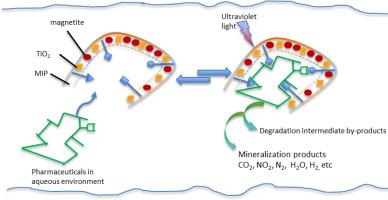Applications of molecularly imprinted titania-based photocatalysis for degradation of pharmaceutical pollutants in the aqueous environment
IF 5.4
Q2 ENGINEERING, ENVIRONMENTAL
引用次数: 0
Abstract
Pharmaceutical residues and their ecotoxicological impact on aquatic organisms are well documented which has forced researchers to shift focus towards finding sustainable pollution control technologies that can effectively control their levels in the environment. Photocatalytic degradation has offered a viable alternative with the ability to eliminate pharmaceutical residues through degradation and eventual mineralization to less-toxic products. Despite its documented successes, photocatalysis still has its challenges that relate to the presence of scavengers of photogenerated radicals and decomposed matrices accumulating on the surface of the photocatalyst. This has led to the incorporation of molecularly imprinted polymers on the surface of the photocatalyst to allow only selected targets to reach the photocatalyst. This review provides a concise yet comprehensive look at the integration of photocatalysis with molecular imprinting technology focussing on titania-based photocatalysts combined with molecularly imprinted polymers for selective degradation of pharmaceutical pollutants in the aqueous environment. The principles, applications, challenges and future directions of molecularly imprinted photocatalytic degradation as a technology for the remediation of pharmaceuticals in aqueous environments are highlighted.

基于分子印迹的二氧化钛光催化技术在水环境中降解制药污染物中的应用
药物残留及其对水生生物的生态毒理影响已有大量文献记载,这迫使研究人员将重点转向寻找可有效控制环境中药物残留水平的可持续污染控制技术。光催化降解技术提供了一种可行的替代方法,它能够通过降解消除药物残留,并最终矿化为毒性较低的产品。尽管光催化技术取得了有目共睹的成功,但它仍然面临着一些挑战,这些挑战与光催化剂表面积累的光生自由基清除剂和分解基质的存在有关。因此,人们在光催化剂表面加入了分子印迹聚合物,只允许选定的目标到达光催化剂。本综述简明而全面地介绍了光催化与分子印迹技术的结合,重点是二氧化钛基光催化剂与分子印迹聚合物的结合,用于选择性降解水环境中的制药污染物。重点介绍了分子印迹光催化降解作为水环境中药物修复技术的原理、应用、挑战和未来发展方向。
本文章由计算机程序翻译,如有差异,请以英文原文为准。
求助全文
约1分钟内获得全文
求助全文
来源期刊

Journal of hazardous materials advances
Environmental Engineering
CiteScore
4.80
自引率
0.00%
发文量
0
审稿时长
50 days
 求助内容:
求助内容: 应助结果提醒方式:
应助结果提醒方式:


